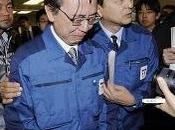Tokyo .- The high concentrations of radioactive material detected on Sunday in the reactor 2 and in waters near the nuclear power plant in Fukushima make Nipponese authorities fear that there is a leakage of substances from the nucleus of a reactor. Tokyo Electric Power (TEPCO), operator of the Fukushima Daiichi plant, indicated on Sunday that it has detected a concentration of radioactivity 10 million above normal in the water that flooded part of the basement of the turbine building of unit 2 but he has clarified that this figure was excessive and should be retested.
Nuclear Security Agency has said that radiation is 1,000 millisievert at the time and adds to the announcement that the level of radioactive material in coastal waters near the center have also increased significantly. Hideko Nishiyama, a spokesman for Japan's nuclear agency, acknowledged on Sunday at a news conference that the radiation level detected in the reactor 2 is high and added that "it is likely that (the leak) comes from the reactor." According to the opinion of experts consulted by the Japanese NHK television, high levels of radioactivity in the unit 2 could indicate damage to the reactor core or in the pipes that carry radioactive water from the turbines and the core.
Meanwhile, Nishiyama has recognized that there may be a leak that is continuously releasing radioactive materials into the sea, although the origin remains unknown. Japan government spokesman Yukio Edan, on Sunday urged TEPCO to clarify the source of the leaks and pointed out that attempts to determine whether radioactive contamination has exceeded containment measures and passed to the soil surrounding the plant.
The sea water near the center (330 meters south) has moved from Friday concentrations 1,250 times above the legal limit to the 1,850 times in the samples made public on Saturday and Sunday. On Thursday, these levels were around the 104 times the maximum allowed. However, the Nuclear Security Agency has recalled that detected radioactive iodine isotopes, which have a relatively short life, will dissolve and degrade before they can have serious effects on the ocean.
An indication that a leak of highly radioactive material began to surface on Thursday, when three workers at the plant were exposed to high radiation levels in the turbine building of the reactor 3 to pass through an area with several feet of water. The three workers were hospitalized, two of them immediately after the incident, but will be discharged soon, the local agency Kyodo.
Analyses of Nuclear Safety Agency and TEPCO said that the water with high levels of radiation found in the turbine building units 1, 2 and 3. According to NHK, the substances released into the leaks include isotopes of iodine and cesium produced in fission reactions, giving from the reactor core.
TEPCO plans to pump the radioactive water that has accumulated in the turbine building of the reactors to the condenser, where steam passes from the liquid core for reuse. This radioactive water flooding has interrupted work on the central unit 2 of Fukushima, whose workers returned this morning the light panels and fight against the reactor to activate the vital cooling systems.
Nuclear Security Agency said today that high levels of radiation in the central facilities will not have immediate negative effects outside the evacuation area of 20 km around the plant. Despite this, the government on Friday urged residents between 20 and 30 miles to travel to other places before the problems get them food, fuel and other supplies.
According to the latest data from the Ministry of Education and Science of Japan, the radiation levels in the border area of 30 km are relatively high, but do not pose an immediate risk to health. TEPCO misinformation has apologized for posting on Sunday that the No. 2 reactor at Fukushima-1 had radiation levels reached ten million times higher than normal.
This information on radiation in the reactor water is wrong, explained a vice president of TEPCO, Sakae Muto, as recorded by Japanese television network NHK. Muto has announced that it will conduct further tests of radiation filtered water samples inside the turbine building that houses the reactor, as the figure of 2,900 million becquerels announced this morning belonged not to the iodine-134, but a radioactive substance with a much lower life.
The sample examined this morning but did have high levels of radiation of about 1,000 mSv per hour, has confirmed Muto 


Nuclear Security Agency has said that radiation is 1,000 millisievert at the time and adds to the announcement that the level of radioactive material in coastal waters near the center have also increased significantly. Hideko Nishiyama, a spokesman for Japan's nuclear agency, acknowledged on Sunday at a news conference that the radiation level detected in the reactor 2 is high and added that "it is likely that (the leak) comes from the reactor." According to the opinion of experts consulted by the Japanese NHK television, high levels of radioactivity in the unit 2 could indicate damage to the reactor core or in the pipes that carry radioactive water from the turbines and the core.
Meanwhile, Nishiyama has recognized that there may be a leak that is continuously releasing radioactive materials into the sea, although the origin remains unknown. Japan government spokesman Yukio Edan, on Sunday urged TEPCO to clarify the source of the leaks and pointed out that attempts to determine whether radioactive contamination has exceeded containment measures and passed to the soil surrounding the plant.
The sea water near the center (330 meters south) has moved from Friday concentrations 1,250 times above the legal limit to the 1,850 times in the samples made public on Saturday and Sunday. On Thursday, these levels were around the 104 times the maximum allowed. However, the Nuclear Security Agency has recalled that detected radioactive iodine isotopes, which have a relatively short life, will dissolve and degrade before they can have serious effects on the ocean.
An indication that a leak of highly radioactive material began to surface on Thursday, when three workers at the plant were exposed to high radiation levels in the turbine building of the reactor 3 to pass through an area with several feet of water. The three workers were hospitalized, two of them immediately after the incident, but will be discharged soon, the local agency Kyodo.
Analyses of Nuclear Safety Agency and TEPCO said that the water with high levels of radiation found in the turbine building units 1, 2 and 3. According to NHK, the substances released into the leaks include isotopes of iodine and cesium produced in fission reactions, giving from the reactor core.
TEPCO plans to pump the radioactive water that has accumulated in the turbine building of the reactors to the condenser, where steam passes from the liquid core for reuse. This radioactive water flooding has interrupted work on the central unit 2 of Fukushima, whose workers returned this morning the light panels and fight against the reactor to activate the vital cooling systems.
Nuclear Security Agency said today that high levels of radiation in the central facilities will not have immediate negative effects outside the evacuation area of 20 km around the plant. Despite this, the government on Friday urged residents between 20 and 30 miles to travel to other places before the problems get them food, fuel and other supplies.
According to the latest data from the Ministry of Education and Science of Japan, the radiation levels in the border area of 30 km are relatively high, but do not pose an immediate risk to health. TEPCO misinformation has apologized for posting on Sunday that the No. 2 reactor at Fukushima-1 had radiation levels reached ten million times higher than normal.
This information on radiation in the reactor water is wrong, explained a vice president of TEPCO, Sakae Muto, as recorded by Japanese television network NHK. Muto has announced that it will conduct further tests of radiation filtered water samples inside the turbine building that houses the reactor, as the figure of 2,900 million becquerels announced this morning belonged not to the iodine-134, but a radioactive substance with a much lower life.
The sample examined this morning but did have high levels of radiation of about 1,000 mSv per hour, has confirmed Muto



- Japan: radioactivity levels spike in seawater near Fukushima (26/03/2011)
- "TEN MILLION Times Normal Radioactivity at Fukushima #2" and related posts (27/03/2011)
- Radioactive pools block reactor repairs (27/03/2011)
- Unmanned vehicles start to be used at Fukushima reactor (19/03/2011)
- Defect concealed in Fukushima No. 4 reactor: engineer (23/03/2011)
No comments:
Post a Comment